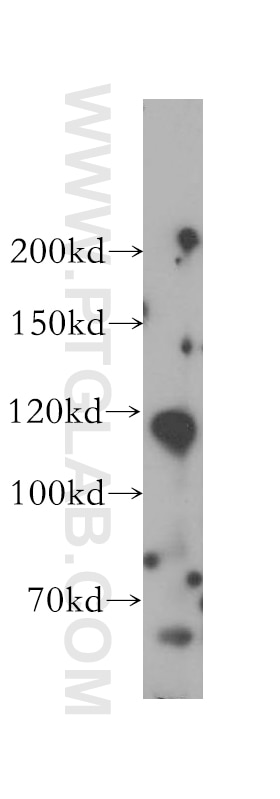Tested Applications
| Positive WB detected in | mouse testis tissue, HepG2 cells, MCF-7 cells |
Recommended dilution
| Application | Dilution |
|---|---|
| Western Blot (WB) | WB : 1:500-1:2000 |
| It is recommended that this reagent should be titrated in each testing system to obtain optimal results. | |
| Sample-dependent, Check data in validation data gallery. | |
Published Applications
| WB | See 2 publications below |
| IF | See 2 publications below |
Product Information
17061-1-AP targets PMFBP1 in WB, IF, ELISA applications and shows reactivity with human, mouse samples.
| Tested Reactivity | human, mouse |
| Cited Reactivity | human, mouse |
| Host / Isotype | Rabbit / IgG |
| Class | Polyclonal |
| Type | Antibody |
| Immunogen |
CatNo: Ag10789 Product name: Recombinant human PMFBP1 protein Source: e coli.-derived, PGEX-4T Tag: GST Domain: 673-1022 aa of BC028423 Sequence: ELQCCSTQLESSLNKYNTSQQVIQDLNKEIALQKESLMSLQAQLDKALQKEKHYLQTTITKEAYDALSRKSAACQDDLTQALEKLNHVTSETKSLQQSLTQTQEKKAQLEEEIIAYEERMKKLNTELRKLRGFHQESELEVHAFDKKLEEMSCQVLQWQKQHQNDLKMLAAKEEQLREFQEEMAALKENLLEDDKEPCCLPQWSVPKDTCRLYRGNDQIMTNLEQWAKQQKVANEKLGNQLREQVKYIAKLSGEKDHLHSVMVHLQQENKKLKKEIEEKKMKAENTRLCTKALGPSRTESTQREKVCGTLGWKGLPQDMGQRMDLTKYIGMPHCPGTSAIGQKNKCDFFL Predict reactive species |
| Full Name | polyamine modulated factor 1 binding protein 1 |
| Calculated Molecular Weight | 1022 aa, 119 kDa |
| Observed Molecular Weight | 119 kDa |
| GenBank Accession Number | BC028423 |
| Gene Symbol | PMFBP1 |
| Gene ID (NCBI) | 83449 |
| RRID | AB_2299881 |
| Conjugate | Unconjugated |
| Form | Liquid |
| Purification Method | Antigen affinity purification |
| UNIPROT ID | Q8TBY8 |
| Storage Buffer | PBS with 0.02% sodium azide and 50% glycerol, pH 7.3. |
| Storage Conditions | Store at -20°C. Stable for one year after shipment. Aliquoting is unnecessary for -20oC storage. 20ul sizes contain 0.1% BSA. |
Protocols
| Product Specific Protocols | |
|---|---|
| WB protocol for PMFBP1 antibody 17061-1-AP | Download protocol |
| Standard Protocols | |
|---|---|
| Click here to view our Standard Protocols |
Publications
| Species | Application | Title |
|---|---|---|
Nat Commun The missing linker between SUN5 and PMFBP1 in sperm head-tail coupling apparatus. | ||
Mol Genet Genomic Med Novel mutations of PMFBP1 in a man with acephalic spermatozoa defects. | ||
Alzheimers Res Ther Spermidine/spermine-N1-acetyltransferase ablation impacts tauopathy-induced polyamine stress response. | ||








